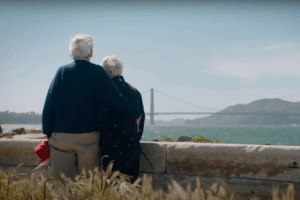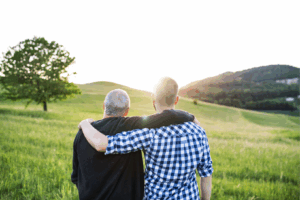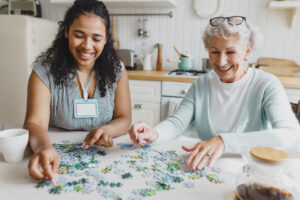Mary’s modest two-story home, situated in San Francisco’s Mission District, was filled with over 3 decades of memories: framed photographs and art she had acquired over her lifetime adorned the walls, and her beloved keepsakes were proudly displayed on countertops. Her late husband’s recliner still sat next to her favorite comfy chair, covered with a handstitched quilt that Mary had made from his shirts.
A second-floor bedroom once belonging to her daughter had been converted into an artist’s studio, but Mary had not used it regularly for several years: walking up stairs had become too big of a challenge. Her daughter, Sarah, lived nearby in East Bay and visited regularly. She began to notice that while Mary insisted there was no other place she’d rather live, she seemed to be having difficulties navigating and maintaining the house. Yet Mary’s home was filled with her memories and personal treasures. It was also located in an ideal spot: she was able to walk to her local grocery store and easily take the MUNI throughout the city. Despite the apparent challenges of Mary staying in her home, Sarah recognized that the benefits far outweighed any obstacles. She also realized how set Mary was on continuing to live in her beloved house, so Sarah set about making it as safe as it could be.
Assessing Your Loved One’s Home for Safety
When evaluating the suitability of your loved one’s home for aging in place, noting and addressing potential safety issues is an important step. Some situations can be easily remedied by small fixes or minor remodeling, while more extensive renovations might be required at times to make their home more accessible.
- Ensure all stairs have railings
Many San Francisco homes have multiple levels, and more multistory residential buildings are being built to accommodate the growing population. Because of the high rent costs here, your loved one might not have a choice about navigating a climb. But stairs can be a dangerous spot for accidents to occur within the home: 90% of hip fractures and the majority of injuries suffered by older adults in America come from falls. Try to place everything your loved one needs on the ground floor to minimize stair use, or install railings on both sides of the staircase when this is not possible.
- Create wheelchair and walker accessibility
When your loved one begins to need the assistance of a walker or wheelchair, there are certain issues to keep an eye out for. Put a cord protector over any loose cords that sit on the floor to prevent tripping. Minimize thresholds between rooms with a similar covering to make the ground more even to walk or roll on. Since many San Francisco homes have steps leading up to the front entrance, try adding a small outdoor ramp to make this more manageable. Older houses might also require a larger project—enlarging the width of doorways to accommodate a wheelchair.
- Keep bathrooms safe
Bathtubs that you climb inside can be very luxurious, but also quite hazardous for older adults. Make sure there are railings installed on all walls surrounding the tub, and that they’re very easy to grip. A large, slip-resistant mat is also essential to prevent falls inside the shower or bathtub. And having a plush bath mat on the ground to soak up water will help minimize the chance of slipping on the floor. Additional railings next to the toilet will make standing and sitting easier.
- Make floors slip-resistant
Plenty of San Francisco’s older homes, and even those built in the eighties, feature beautiful hardwood flooring. But wood, tile, and linoleum floors can be quite slippery. Carpet, on the other hand, provides traction and is also soft on bare feet. If you can’t re-carpet, consider adding some large area rugs instead. Another option is to add a slip-resistant treatment to uncarpeted floors.
- Add extra seating
Strategically placed seating creates built-in rest areas for your loved one. Make sure there’s always a comfortable chair nearby stairs, as well as hallways. Place some pillows for additional relaxation, and maybe a small coffee table with a book or water jug. You can also install railings in these spots to make sitting and standing easier.
- Replace doorknobs with levers
Opening doors can prove challenging for some adults who find the twisting motion of standard doorknobs too strenuous. Some of the older homes in San Francisco have smaller doorknobs that are charming to look at and full of vintage character—but these can be incredibly finicky to use. Lever-style doorknobs are better suited if your loved one has difficulties with hand strength or fine motor skills, as they offer a larger surface to grip and allow the use of full arm strength to push down. Caregivers might also want to consider replacing front door locks if the old ones are tricky to use.
- Light up dark places
Ensuring proper lighting throughout your loved one’s home can make a big difference in their safety. This is especially important for San Francisco’s notorious gray foggy days where natural light might not be enough. Light switches should be large and easy to see, or you can even get remote controlled lighting for extra convenience. Replace any small lamps that have finicky or hard-to-reach switches with more accessible lighting options.
Keeping Them Connected to the San Francisco They Love
Your loved one’s community is just as important as their home’s indoor safety features to ensuring their ability to safely age in place. Having easy access to entertainment and nature, whether by foot or affordable public transportation, greatly increases his or her quality of life. San Francisco’s extensive public transit system is one of the best in the country, and the city also offers a huge range of special services focused on enhancing senior accessibility:
- Discounted green tickets for BART
- SilverRide cab services
- Lyft for Good car rides
- Escorted transportation
- Bay Area Bikeshare
- San Francisco Paratransit
- Uber Assist
- Free WiFi in popular areas
- Technology classes for seniors
While San Francisco already boasts a large population of older adults, these numbers are expected to keep growing throughout the Bay Area. This bodes well for future programs and facilities that cater to this steadily increasing demographic. San Francisco’s healthy outdoor lifestyle, (mostly) temperate year-round weather, and low property crime rate create an ideal environment for aging adults. Whether your loved one already has a home in the Bay Area or is looking to purchase one, you can help ensure it has the necessary safety features for securely aging in place so that your loved one is free to take advantage of all the great city of San Francisco has to offer.
For caregivers or family members seeking additional support for their aging loved ones, Institute on Aging offers a range of resources and services. To learn more about our work in the Bay Area, connect with us today.







